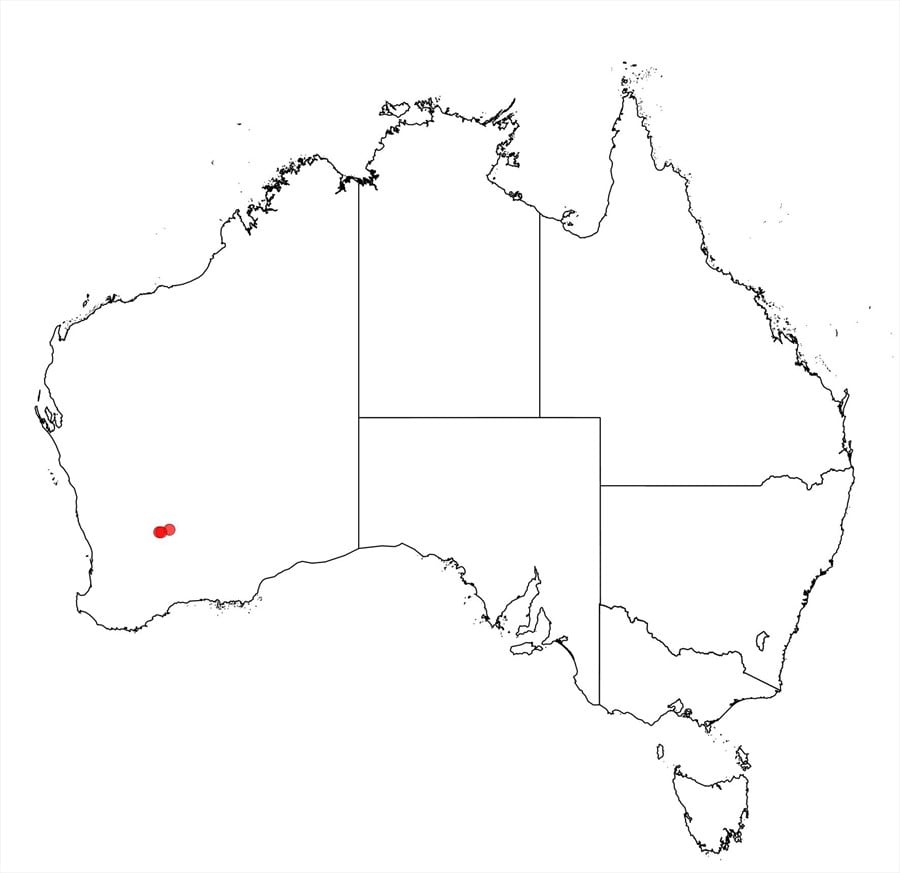Acacia haematites Maslin
WATTLE
Acacias of Australia
Common Name
Koolyanobbing Ironstone Wattle
Family
Fabaceae
Distribution
Known from only a single range near Koolyanobbing, c. 50 km NE of Southern Cross, W.A.
Description
Diffuse shrub to c. 1 m tall. Upper branches dividing into ±numerous, short, straight, rigid, spinose or sub-spinose, glabrous branchlets. Bark grey. Stipules early caducous, 1–2 mm long, not fused. Phyllodes narrowly oblong to narrowly lanceolate, narrowed towards apex, 6–12 mm long, 1–2 mm wide, pungent by a slender subulate dark brown cusp 1–1.5 mm long, flat, straight, patent, rigid, glabrous or hirtellous as on branchlets but hairs slightly shorter; midrib ±prominent, upper margin 2-nerved below gland and 1-nerved above gland; sessile with pulvinus ±absent; gland not prominent, (1–) 2–5 mm above base. Inflorescences simple; heads globular, ±sessile, 5–9-flowered; bracteoles widely spathulate, ±sessile, 1–1.5 x c. 1 mm, concave, brown, obtuse. Flowers 5-merous; calyx gamosepalous, widely turbinate. Pods ±linear to sub-moniliform, to c. 35 mm long (expanded length), 2.5–3 mm wide, irregularly strongly curved to openly coiled or twisted, undulate, prominently rounded over seeds, glabrous, dark brown to black; aril clavate, c. ½ as long as seed.
Phenology
Flowers Aug.–Sept.
Habitat
Grows on the eroded slopes below massive ironstone or lateritized duricrust outcrops of a haematite-rich, Banded Iron Formation range in open shrubland.
Notes
This species was noted by B.R.Maslin, Fl. Australia 11A: 473 (2001), as an outlier of A. acuaria, based on B.R.Maslin 1958a. Indeed, it is most closely related to the more westerly distributed A. acuaria which is distinguished by having fused stipules (that fall away as a single unit) and distinctly pedunculate heads that are more numerously flowered; also, the phyllodes of A. acuaria are terete to sub-terete (but flat when dry), more slender and possess a less pronounced midrib and have a discernible (but short) basal pulvinus. Acacia haematites superficially resembles long phyllode forms of A. intricata which are distinguished by bracteoles and calyces either absent or highly reduce and phyllodes that are thicker and strongly 2-nerved along their upper margin (the nerves extending from base to apex, not coalescing at the gland as occurs in A. haematites).
Conservation
Acacia haematites is listed as Priority One under Department of Parks and Wildlife Conservation Codes for Western Australian Flora.
FOA Reference
Flora of Australia Project
Author
B.R. Maslin
This identification key and fact sheets are available as a mobile application:
URL: https://apps.lucidcentral.org/wattle/
© Copyright 2018. All rights reserved.






